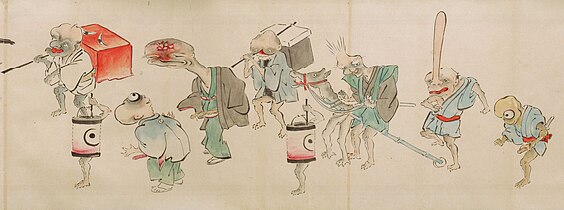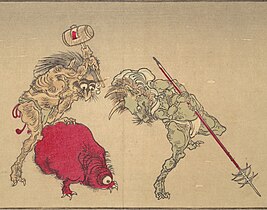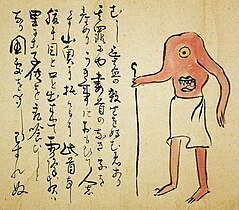Shodoshima Yokai Art Museum
The Shodoshima Yokai Art Museum,[1] also known as the Yokai Bijutsukan Art Museum is a small museum in Kagawa prefecture, which is focused on yōkai, supernatural entities in Japanese folklore.
Description
[edit]The museum, directed by Yagyu Chuebi, contains approximately nine hundred examples of Yokai.[2][3] The museum is located on Shodoshima island, in the area known as the "maze district", in four wooden structures from the Meiji Era.[2] The collection consists of works by several artists some of which have been acquired through the Yokai Art Contest annually over the past decade.[2][1]
The origins of yokai folklore go back to the 11th century. The 18th century artist and scholar, Toriyama Sekien, brought attention to yokai folklore through his illustrated encyclopedia of monsters.[2] Yokai have been described as the human imagination at work to process "fear, awe, and anxiety toward nature and unknown presences that writhe within the darkness."[4] Yōkai are mischievous creatures, sometimes considered demonic, that shed light on mysterious or unexplained phenomena, for example, damaging winds or noises in the night that cannot be explained.[2] There are three basic types of yōkai, Obake who are usually depicted as shapeshifting monsters; Yurei, that are ghosts; and the more general Yōkai.[3]
Gallery
[edit]-
Far right art detail of scroll depicting Yokai betrothal, marriage, and home life, 16th century or 17th century
-
Yōkai artwork from "Kyōsai Kawanabe's Pictures of One Hundred Demons (1890), woodblock printed book (orihon, accordion-style); ink and color on paper.
-
Yokai without a head
See also
[edit]References
[edit]- ^ a b Joslin, Matthew. "Ghost stories: What is a 'yokai' and why is it important, with artist Chubei Yagyu". Japan Travel. Retrieved 17 March 2024.
- ^ a b c d e Rich, Motoko; Hida, Hikari. "A Japanese Island Where the Wild Things Are". The New York Times. Retrieved 17 March 2024.
- ^ a b "Gathering of Japanese Monsters – the Yokai Art Museum in Shodoshima". Life Takamatsu. Retrieved 17 March 2024.
- ^ Irsyad, M. (24 November 2023). "'Yokai Parade' exhibition in KL unleashes supernatural monsters from Japan". The Star. Retrieved 17 March 2024.
Further reading
[edit]Xu, Wang. Painting the different sides of Setouchi, China Daily



